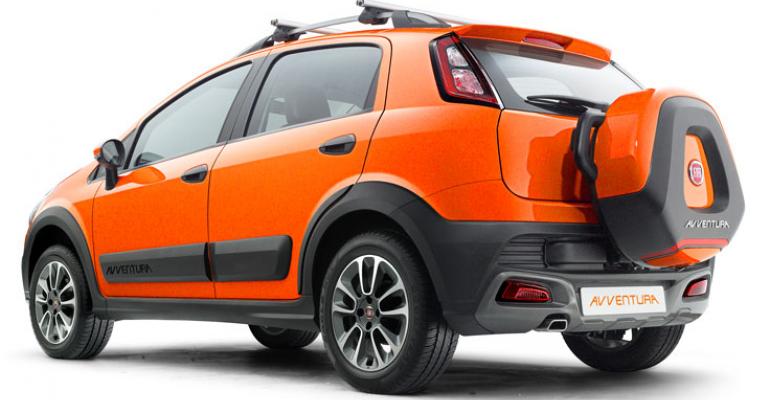MUMBAI – Already a minor player in the Indian market, Fiat Chrysler Automobiles is struggling to keep from backsliding even farther as its upscale product strategy backfires.
FCA’s Fiat India branch has had considerable success as a manufacturer of engines and as a contract assembler. But by overlooking the Indian market’s preference for affordable compact cars, the automaker has seen sales plummet from a high of 22,757 in 2009 to just 5,764 from January through September, down 39% from like-2014, according to WardsAuto data.
Fiat currently has only three entries in the Indian market: the Linea sedan, Punto hatchback and Avventura compact CUV. FCA in May 2014 forecast 51% annual growth to 130,000 deliveries by 2018, but those projections were drawn in part from the launch of the Jeep brand and Abarth sub-brand – which, unlike in developed markets, are considered luxury models in India.
Giancardo Bertoldi, Fiat engineering chief for Asia Pacific, acknowledges during a visit to India: “Yes, we made some mistakes in designing the cars for India. But all was done from (Fiat headquarters) in Turin.
“Fiat products are very good, but they were poorly adapted to the Indian market.”
One such big-ticket Fiat model is the newly launched Abarth 595 Competizione, an upgrade of the Abarth 500 – itself an upgrade of the Fiat 500 – priced at more than Rs3.2 million ($50,000). Fiat has launched an Abarth version of the Punto, to be followed in coming months by the Linea and Avventura, even as the Indian market continues skewing toward inexpensive, high-volume cars.
Society of Indian Auto Manufacturers data shows sales of microcars, minicars and compacts totaled 1.9 million in the 2014-2015 fiscal year, or 73% of 2.6 million overall. Market leaders Maruti Suzuki, Hyundai, Tata and three other smaller automakers offer 19 small models with 120 variants, each costing between Rs300,00-Rs600,000 ($4,600-$9,200).
Engines Power Profitability
While Fiat struggles to sell cars in India, it has had considerable success as an engine manufacturer. Its production joint venture with Tata at Ranjangaon turned a profit four years ago and in the fiscal year ending in March reported after-tax profits of Rs4 billion ($61 million).
Sales of Fiat vehicles through Tata dealers have been discontinued, but the JV is building 360,000 engines a year – maximum capacity – at Ranjangaon. It also is assembling 160,000 cars a year there under contract with Maruti Suzuki, Tata and Chevrolet.
The JV’s main revenue source is the 1.3L MultiJet diesel engine used by Fiat, Maruti Suzuki, Tata, Chevrolet and Premier (which builds a single compact SUV from complete-knocked-down kits made by China’s Zotye Auto) for their 18 different models and possibly five more. Six million of these engines already are driving light vehicles on Indian roads.
Fiat also is redeveloping its 1.6L JTD global diesel engine into a new and more powerful 1.5L version for its new hatchback, compact sedan and compact SUV due to reach the Indian market in 2016 or 2017. Under Indian tax laws, cars with 1.5L or smaller engines receive enhanced tax breaks.
Fiat and Tata, meanwhile, are collaborating on a new-generation FCA 2.0L turbocharged diesel MultiJet engine earmarked for two ’17-model luxury Tata SUVs being developed with Jaguar Land Rover and eventually for an FCA Jeep-brand C-segment SUV.
To facilitate Jeep’s launch in India, Fiat is investing Rs17.8 billion ($272 million) in a second plant at Ranjangaon and to streamline the existing plant.
Not satisfied to coast on profits from engine building, Fiat is revisiting its India car-building and -marketing strategies to deliver the same qualities consumers are looking for in its competitors’ products, says Kevin Flynn, Fiat India’s new president and managing director.
Toward that end, Fiat has developed a flexible new platform codenamed 326 to be used for a new range of Fiat models. It can be adapted to a variety of body styles ranging from minicar to fullsize. It has been tested extensively and is in use in Brazil.
That flexibility should allow Fiat to bring new models to market more quickly. High-volume manufacturers such as Maruti Suzuki or Hyundai can afford the 6-month intervals between model launches currently in place at Fiat, but the smaller automaker cannot – especially when trying to keep up with competitors’ new technologies.
A potentially successful entry in the Indian market may be the Aegea compact sedan. Similar to Fiat’s 500 series models, it may replace the slow-selling Linea. The Aegea could become the bridge in styling and image between the old Fiat and the one envisioned by Flynn, who says, “I am really keen to get Fiat to be a player of note in India.”





